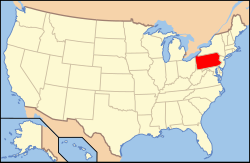Uniontown, Pennsylvania
| Uniontown, Pennsylvania | |
|---|---|
| City | |
| City of Uniontown | |
 Location of Pennsylvania in the United States |
|
| Location of Uniontown within Pennsylvania | |
| Coordinates: 39°54′0″N 79°43′28″W / 39.90000°N 79.72444°WCoordinates: 39°54′0″N 79°43′28″W / 39.90000°N 79.72444°W | |
| Country | United States |
| State | Pennsylvania |
| County | Fayette |
| Established | 1776-07-04 |
| Government | |
| • Mayor | Bernard Kasievich |
| Area | |
| • Total | 2.04 sq mi (5.3 km2) |
| • Land | 2.04 sq mi (5.3 km2) |
| • Water | 0.0 sq mi (0 km2) |
| Elevation | 999 ft (304 m) |
| Population (2010) | |
| • Total | 10,372 |
| • Density | 5,100/sq mi (2,000/km2) |
| Time zone | EST (UTC-5) |
| • Summer (DST) | EDT (UTC-4) |
| Area code(s) | 724 |
Uniontown is a city in Fayette County, Pennsylvania, United States, 46 miles (74 km) southeast of Pittsburgh and part of the Pittsburgh Metro Area. The population was 10,372 at the 2010 census, down from 12,422 at the 2000 census. It is the county seat and largest city of Fayette County.
Popularly known as "Beesontown", the "town of Union" was founded by Henry Beeson on July 4, 1776, coincidentally the same date the United States Declaration of Independence was ratified. The National Road, also known as the Cumberland Road, was routed through Uniontown in the early 19th century, and the town grew along with the road (now US 40). 10 miles (16 km) southeast of Uniontown is Fort Necessity, built by George Washington during the French and Indian War (part of the international Seven Years' War) as well as the site of the Battle of Jumonville Glen, where the North American branch of the war began.
Uniontown's role in the Underground Railroad in the antebellum years is commemorated by a marker on the corner of East Main Street and Baker Alley. Residents helped slaves escaping from the South to freedom.
In the late nineteenth century, the town grew based on the development of coal mines and the steel industry. Uniontown was the site of violent clashes between striking coal miners and guards at the local coke works during the bituminous coal miners' strike of 1894. Fifteen guards armed with carbines and machine guns held off an attack by 1,500 strikers, killing five and wounding eight.
...
Wikipedia

